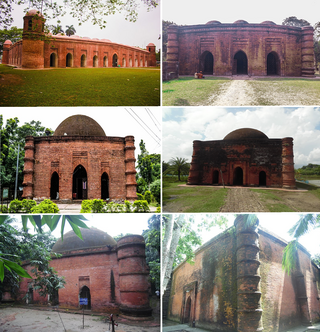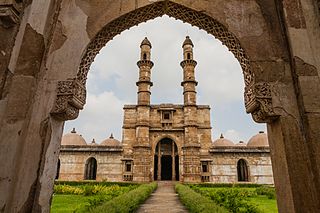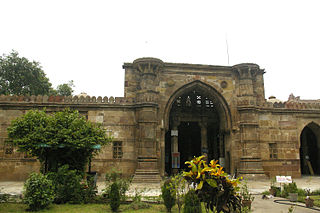Rasini | |
|---|---|
Town | |
| Country | |
| Gobol | Lower Juba |
| Time zone | UTC+3 (EAT) |
Rasini, also known as Kikoni, is a small town in the southern Lower Juba province of Somalia.
Rasini | |
|---|---|
Town | |
| Country | |
| Gobol | Lower Juba |
| Time zone | UTC+3 (EAT) |
Rasini, also known as Kikoni, is a small town in the southern Lower Juba province of Somalia.
Rasini is situated in the southernmost part of the country, opposite Chula on the Bajuni Islands. It is positioned on top of a low coral cliff on the littoral. [1]
The area is one of the more prominent archaeological sites in southern Somalia. In earlier charts and maps, it is alternately identified as "Castellated Ruin" or "Portuguese Castle". [1]
Rasini contains a number of monuments. Among these structures is a small mosque, whose mihrab Grottanelli suggests is among the best examples of Islamic art in the wider region. [1] The wall niche has a short arch and a very high capital. [2] A tomb lies above the mihrab, which is adorned with a clover leaf design that also appears on another tomb in Koyama and again at Barawa. [3] According to Elliot, who visited Rasini, the masjid was built by Sherif Ismail bin Omar, the son of Chula's tenth recorded headman Sherif Omari. Based on this, the mosque is estimated to have been constructed as late as the 18th century, between 1725 and 1765. [1]
Additionally, Rasini has a number of pillar tombs. These are located on a hill within a five-minute walking distance from the shore, along a "Galla travelling path" to the west of the mosque. Elliot observed three such monuments herein, one of which marked the grave of Sherif Omar Ismail. The second tomb belonged to Sheikh Ali. Its pillar was 5.64 meters in height, circular in shape, and featured six notches earmarked for ceramics, including a "Lamu China" vessel found in the highest depression. The third pillar tomb was that of Sherif Ismail bin Omar himself. Its construction was dated to the same period as the Rasini mosque. The tomb's 4.27m column was different in shape, being rectangular rather than circular. It reportedly once had bowls on display in its frontal notches, with only the highest vessel still extant. An urn also used to sit atop the pillar. [1]
On a ridge in a hill range between the Rasini masjid and Anole Creek, Brenner also noted several "fortified buildings" and a dilapidated mosque. The structures were located around 60 minutes walk from the coast. On the horizon he reported seeing tombs with other monuments on the walls and step-ends at the corners, as well as pillar tombs. Two of the columns stood several meters from the ground. Brenner likewise observed some inscriptions, which were deemed unreadable. [1]

The Prophet's Mosque is the second mosque built by the Islamic prophet Muhammad in Medina, after that of Quba, as well as the second largest mosque and holiest site in Islam, after the Masjid al-Haram in Mecca, in the Saudi region of the Hejaz. The mosque is located at the heart of Medina, and is a major site of pilgrimage that falls under the purview of the Custodian of the Two Holy Mosques.

The ruins of Gedi are a historical and archaeological site near the Indian Ocean coast of eastern Kenya. The site is adjacent to the town of Gedi in the Kilifi District and within the Arabuko-Sokoke Forest.

The Mosque City of Bagerhat is a UNESCO World Heritage Site in Bagerhat District, Bangladesh. It contains 360 mosques, public buildings, mausoleums, bridges, roads, water tanks and other public buildings constructed from baked brick. The mosques were built during the Bengal Sultanate in the 15th century, of which the Sixty Dome Mosque is the largest. Other mosques include the Singar Mosque, the Nine Dome Mosque, the Tomb of Khan Jahan, the Bibi Begni Mosque and the Ronvijoypur Mosque. The mosques were built during the governorship of Ulugh Khan Jahan, a Turkic military officer appointed as governor in the Sundarbans by Sultan Mahmud Shah of Bengal.

The Sixty Dome Mosque, is a mosque in Bagerhat, Bangladesh. It is a part of the Mosque City of Bagerhat, a UNESCO World Heritage Site. It is the largest mosque in Bangladesh from the sultanate period (1352–1576). It was built during the Bengal Sultanate by Khan Jahan Ali, the governor of the Sundarbans. It has been described as "one of the most impressive Muslim monuments in the whole of South Asia."

The Abdul Gaffoor Mosque is a mosque in Little India, Singapore. It is located at Dunlop Street in the Rochor Planning Area.

Sultan Ghari was the first Islamic Mausoleum (tomb) built in 1231 AD for Prince Nasiruddin Mahmud, eldest son of Iltumish, in the "funerary landscape of Delhi" in the Nangal Dewat Forest, Near Nangal Dewat Vasant Kunj).

Jahanpanah was the fourth medieval city of Delhi established in 1326–1327 by Muhammad bin Tughlaq (1325–51), of the Delhi Sultanate. To address the constant threat of the Mongols, Tughlaq built the fortified city of Jahanpanah subsuming the Adilabad fort that had been built in the 14th century and also all the establishments lying between Qila Rai Pithora and Siri Fort. Neither the city nor the fort has survived. Many reasons have been offered for such a situation. One of which is stated as the idiosyncratic rule of Mohammed bin Tughlaq when inexplicably he shifted the capital to Daulatabad in the Deccan and came back to Delhi soon after.

Somali architecture is the engineering and designing of multiple different construction types such as stone cities, castles, citadels, fortresses, mosques, temples, aqueducts, lighthouses, towers and tombs during the ancient, medieval and early modern periods in Somalia and other regions inhabited by Somalis, as well as the fusion of Somalo-Islamic architecture with Western designs in contemporary times.

Choto Shona Mosque is located in Chapai Nawabganj district of Bangladesh. The mosque is situated about 3 kilometres (1.9 mi) south of the Kotwali Gate and 0.5 kilometres (0.31 mi) to the south-east of the Mughal Tahakhana complex in the Firozpur Quarter.

Jama Masjid, also known as Jumah Mosque or Jami' Masjid, is a mosque in Ahmedabad, Gujarat, India. It and was built in 1424 during the reign of Ahmad Shah I. The inscription on the central mihrab commemorates the inauguration of the mosque on the 1st Safar A.H. 827 or January 4, 1424 A.D. by Sultan Ahmad Shah I. The mosque lies in the old walled city, and it is situated outside Bhadra Fort area. The old walled city is divided into separate quarters or pols, and the Jami' Masjid is found on the Gandhi Road. Along the south side of the road, the mosque is a short distance beyond the Teen Darwaza or Tripolia Gate.

Firoz Shah palace complex (Hisar-e-Firoza) is an archaeological complex located in modern-day Hisar, in the Haryana state of India, built by Firoz Shah Tughlaq of the Delhi Sultanate in 1354 AD. It is maintained by the Archaeological Survey of India.

Jami Masjid in Champaner, Gujarat state, western India, is part of the Champaner-Pavagadh Archaeological Park, a UNESCO World Heritage Site, and is among the 114 monuments there which are listed by the Baroda Heritage Trust. It is located about 150 feet (46 m) east of the city walls (Jahdnpandh), near the east gate.

There are eleven different types of buildings at the UNESCO-protected Champaner-Pavagadh Archaeological Park in Gujarat, India, including mosques, temples, granaries, tombs, wells, walls, and terraces. The monuments are situated at the foot of and around the Pavagadh Hill. The Baroda Heritage Trust lists 114 monuments in the area, of which only 39 are maintained by the Archaeological Survey of India, due to limited funding. The Forest Department owns 94% of the land here, while the temple trusts and other sectarian establishments provide facilities for boarding and lodging to pilgrims and tourists. On the southern side near the foot of the hill some dilapidated houses and the foundations of Jain temples can also be seen.

Ahmad Shah's Mosque, also known as Shahi Jam-e-Masjid or Juni Juma Masjid is the oldest mosque of Ahmedabad, India.

Baba Lului's Mosque, also known as Baba Lavlavie's Masjid, is a medieval mosque and tomb complex in Behrampura area of Ahmedabad, India.
Miandi is a proto-Somali small town in the southern Lower Juba province of Somalia.

Jami Mosque is a mosque in Khambat, Gujarat, India, built in 1325. It is one of the oldest Islamic monuments in Gujarat. The mosque's interior has colonnaded open courtyard built with 100 columns.

The tomb of the noble Isa Khan Niazi is located in the Humayun's Tomb complex in Delhi, India. The mausoleum, octagonal in shape and built mainly of red sandstone, was built in 1547–1548 during the reign of Sher Shah Suri. The mosque of Isa Khan is located west of the mausoleum, which along with other buildings form the UNESCO World Heritage Site of Humayun's tomb complex.

The Hussein Bey Mosque is a mosque located in Constantine, Algeria.